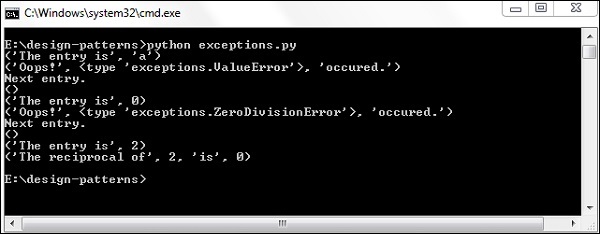Python Design Patterns – Exception Handling
Handling exceptions is also a primary criterion of design patterns. An exception is an error that happens during the execution of a program. When a particular error occurs, it is important to generate an exception. This helps in curbing program crashes.
Why use exceptions?
Exceptions are convenient ways of handling errors and special conditions in a program. When a user thinks that the specified code can produce an error then it is important to use exception handling.
Example – Division by zero
import sys randomList = ['a', 0, 2] for entry in randomList: try: print("The entry is", entry) r = 1/int(entry) break except: print("Oops!",sys.exc_info()[0],"occured.") print("Next entry.") print() print("The reciprocal of",entry,"is",r)
Output
The above program generates the following output −

Raising Exceptions
In Python programming specifically, exceptions are raised when corresponding error of code occurs at run time. This can be forcefully raised using the “raise” keyword.
Syntax
> raise KeyboardInterrupt Traceback (most recent call last): ... KeyboardInterrupt
